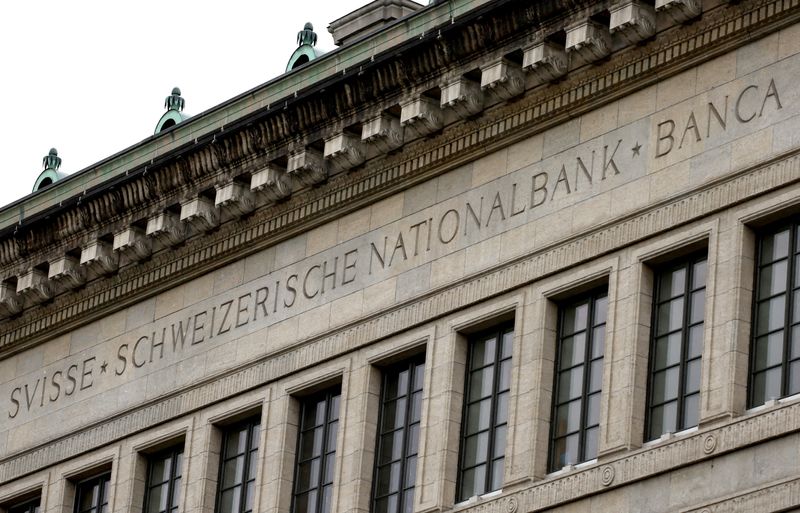By John Revill
ZURICH(Reuters) -The Swiss National Bank cut interest rates on Thursday for the second time running, pointing to easing price pressures that allowed it to maintain its position as a front-runner in the global policy easing cycle now underway.
The Swiss franc weakened against other currencies and stocks gained after the central bank cut its policy rate by 25 basis points to 1.25%, as expected by two-thirds of analysts polled by Reuters, following a quarter-point reduction in March.
The SNB’s decision had been finely balanced, given a recent rebound in economic growth and a break in the trend of gently falling inflation in Switzerland.
“The underlying inflationary pressure has decreased again compared to the previous quarter,” SNB Chairman Thomas Jordan said. “With today’s lowering of the SNB policy rate, we are able to maintain appropriate monetary conditions.”
Jordan later also hinted that this was not the end of the SNB’s current round of easing.
“If you look at inflation, you can see that it is falling slightly,” Jordan told Swiss broadcaster SRF. “That’s why we are not making a forecast or saying that this is the last rate cut.”
Earlier, Jordan pointed to the SNB’s inflation forecasts, which were tweaked downwards and enabled the reduction in interest rates.
Even at the furthest end of its forecasts – covering the first quarter of 2027 – the SNB now expects inflation at 1.0%, well within its 0-2% target range.
The recent rise of the Swiss franc, driven by rising political uncertainty in Europe pushing investors towards the safe haven currency, was also highlighted by Jordan.
The franc has gained 4.5% against the euro in the past month on political concerns, including the upcoming French elections, which could see the far right win power.
The SNB was paying close attention, Jordan said.
“We are ready to be active on the foreign exchange market and that can go in both directions,” he told reporters.
ING economist Peter Vanden Houte said the rate cut was not a big surprise given the recent strengthening of the franc.
“With decent Swiss GDP growth in the first quarter there was no real urgency for the SNB to cut rates, but given the still benign inflation outlook the SNB saw a window to ease,” said Vanden Houte. “For the SNB it was more a rate cut because it could, not because it should.”
Various factors lie behind Switzerland’s low price pressures, including an energy mix that makes the country less exposed to oil and gas costs, wage restraint, and protection against imported price inflation from the strong franc.
STICK OR CUT?
On a busy day for central banks on Thursday, the Bank of England kept its main interest rate unchanged, while Norway’s central bank also held its rates steady.
Thomas Gitzel, chief economist at VP Bank Group, said the SNB had done the right thing by lowering rates again. Had it not, “it could have created the impression the SNB was unsure about its key interest rate reduction in March.”
Cooling inflation allowed the SNB to become the first major central bank to lower rates at its last meeting.
It has since been followed by the European Central Bank, which last week cut rates for the first time in five years.
Canadian and Swedish central banks have also started to bring down borrowing costs that were lifted to tackle the post-pandemic inflation surge. The U.S. Federal Reserve last week, however, held rates steady and pushed out the start of rate cuts to later this year.

Economists said that Thursday’s cut narrowed the scope for more easing for the Swiss central bank, with one more quarter-point move in September a possibility, but not a given.
“With the latest rate cut, the policy rate is now closer to its terminal value, which we estimate at 1.00%,” said Maxime Botteron, economist at UBS in Zurich, referring to a potential end point of the current easing cycle. “This means that the potential for additional cuts is limited.”
https://i-invdn-com.investing.com/news/indicatornews_1_800x533_L_1413124982.jpg
Source link
Reuters




